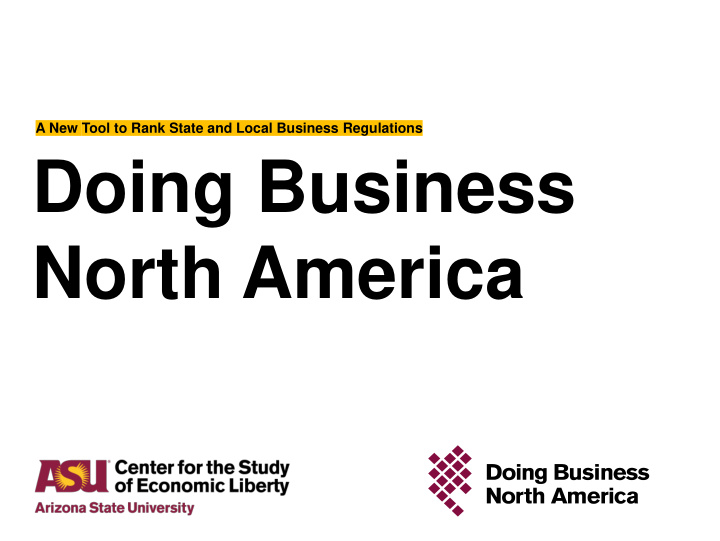



A New Tool to Rank State and Local Business Regulations Doing Business North America
What is Doing Business North America The DBNA annual report provides objective measures of the scale and scope of business regulations in 115 cities in 92 states, provinces, and federal districts across Canada, Mexico and the United States. It uses these measures to score and rank cities in regard to how easy or difficult it is to set up, operate, and shut down a business.
Six Categories Starting a Business Employing Workers Getting Electricity Registering Property Paying Taxes Resolving Insolvency
Top 5 U.S. Cities “Ease of Doing Business” Score
Bottom 5 U.S. Cities “Ease of Doing Business” Score
Starting a Business Measures all procedures officially required for an entrepreneur to start up and formally operate a limited liability company, as well as the time and cost to complete these procedures. These procedures include the processes entrepreneurs undergo when obtaining all necessary approvals, licenses, and permits, and completing any required notifications, verifications, or inscriptions for the company and employees with relevant authorities.
Employing Workers Variables related to the flexibility and regulation of employing workers, specifically as it relates to the areas of hiring, working hours, laying off workers, and leave. There are 13 indicators used to represent the legal requirements or fiscal burdens necessary to comply with an economy’s labor laws. Examples: Minimum wage (as a % of per capita personal income) • Required paid sick and parental leave (in calendar days) •
Getting Electricity All procedures required for a business to obtain a permanent electricity connection and supply for a standard commercial property. The time to complete the necessary procedures listed above is also recorded. In addition, DBNA measures the cost of electricity in two ways: (i) the price of a kilowatt-hour (kWh) of electricity for use in a commercial property, and (ii) the annual cost of electricity used in a commercial property as a percentage of income per capita.
Registering Property All procedures necessary for a business to purchase a property from another business and to transfer the property title to the buyer’s name so that the buyer can use the property for: (i) expanding its business, (ii) collateral in taking new loans, or (iii) selling the property to another business. DBNA also measures the time and cost to complete each of these procedures. Finally, there is also a measure of the quality of the land administration system in each economy. The Quality of Land Administration Index is comprised of two sub-indexes: the Reliability of Infrastructure index and a Transparency of Information index.
Paying Taxes All taxes that are mandated at any level of government (including federal, state/province, and city). Indicators related to personal, corporate, and commercial property tax rates are collected to provide a full spectrum of taxes that businesses, employers, employees, and city residents can expect to pay. This includes city-level income and business profits taxes (where applicable).
Resolving Insolvency The time, cost, and outcome of insolvency proceedings involving domestic entities as well as the strength of the legal framework applicable to judicial liquidation and reorganization proceedings . (This category is national in origin, so all U.S. cities tie for first place.)
City Rankings Search
Economy Snapshot Search
Raw Data Download
Data Spreadsheet
The Next Edition ● Add more cities – potentially have “metro area” comparisons as well ● City-level occupational licensing variables ● Zoning and land-use restrictions ● Any other ideas?
Questions? EconomicLiberty@asu.edu
Recommend
More recommend